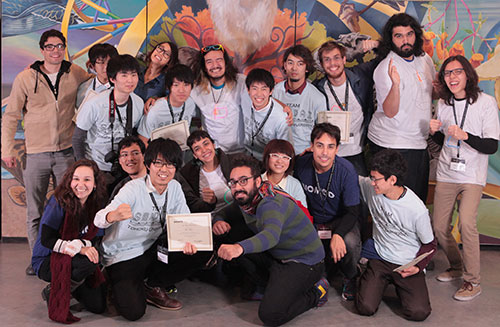The annual biomolecular design competition enables hundreds of international undergraduates to learn the ropes of developing real-world synthetic biology applications
(Cambridge, Mass.) – The Wyss Institute’s fifth annual BIOMOD Jamboree at Harvard University was held October 31-November 1 in Cambridge, bringing together more than 30 international teams of undergraduate students in a competition designed to inspire the next generation of biomolecular innovations and propel young bioengineers into the emerging field of synthetic biology.
The grand prize winners, members of “Team Sendai” from Tohoku University, Japan, unveiled their new method for creating size-controllable, linear nanostructures using DNA origami. The winners were selected by a panel made up of faculty and experts in bionanotechnology, including three former Wyss scientists who are now leading bionanotechnology development around the world: Kurt Gothelf, Ph.D., Professor of Chemistry at Aarhus University, Denmark; Thorston-Lars Schmidt, Ph.D., leader of DNA chemistry research at the Center for Advancing Electronics Dresden at Dresden University of Technology, Germany; and Minseok Kwak, Ph.D., Assistant Professor of Chemistry at Pukyong National University, South Korea.
Students on Team Sendai created modular building components — made of DNA — comprising a cylinder shape with a twisting, internal shaft that rotates. As each piece stacks together, the internal shaft twists, accumulating a phase shift that eventually prevents any more units from attaching to the stack. The phase shift length is programmable so that the final length of a stack can be controlled, enabling the design of precisely tuned nanostructures. The team believes this could lead to fabrication of increasingly complex and well-organized nanostructures.
Runners-up for the grand prize included teams hailing from Ludwig-Maximilians-Universität München, Germany, and Huazong University of Science and Technology (HUST), China. The German team designed a nanoscale ring of DNA – a programmable structure known as “NanocANDy” which can attach to certain sugars that are found in the body – that could be used to investigate cellular pathways and induce cell signal transduction. The team appealed to “Lord of the Rings” fans amongst the BIOMOD audience by presenting their design while donned in pointed elfin ears, long capes, and big costume hobbit feet.

The HUST-China team, which presented DNA “Nanofingers” that can be opened or closed controllably to capture or release proteins, believes that their design can help maintain homeostasis within the body by using Nanofingers to moderate the quantity of a specific protein. The team envisions their design could be used for applications such as encouraging blood coagulation at a site of injury by manipulating proteins like thrombin and hirudin.
The competitive BIOMOD Jamboree not only sparks invention of new methods for fabricating nanostructures using biomolecular components but also exposes young scientists in the field of synthetic biology to peers and mentors that they will likely interact with in the future if they continue to pursue careers in this field. An important part of BIOMOD is the audience choice awards, in which students are able to vote for teams of their peers that they believe deserve accolades for their designs.
This year’s audience recognized the grand-prize-winning Team Sendai as well as University of British Columbia’s “UBerCoolecular” team and University of São Paolo’s “Protomatos” team. Team UBerCoolecular developed a nanostructure that acts as both a combined and targeted cancer therapy, carrying multiple drugs simultaneously and then focusing their release at a highly-specific target of cancer cells without harming nearby healthy cells. Team Protomatos unveiled a process for functionalizing the use of nanocages constructed from DNA origami, making the fabrication process faster, more efficient, and more affordable.
Founded by Shawn Douglas, Ph.D., who is currently Assistant Professor at University of California San Francisco’s Department of Cellular Molecular Pharmacology and was formerly a Technology Development Fellow at the Wyss Institute, BIOMOD gives undergraduates an opportunity to work through the challenges of creating something new in the laboratory while also celebrating their successes amongst a community of peers. It was recently recognized as valuable way for young scientists to gain exposure and training in the field of synthetic biology, according to a Science Careers article published in the journal Science.
Learn more about BIOMOD: http://biomod.net